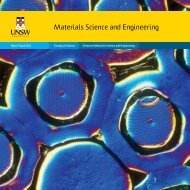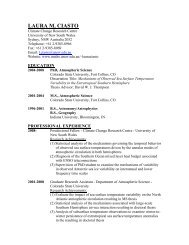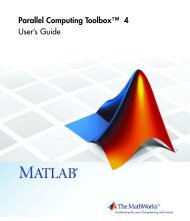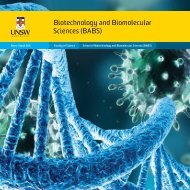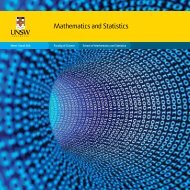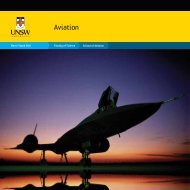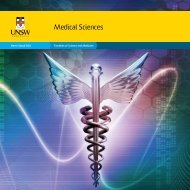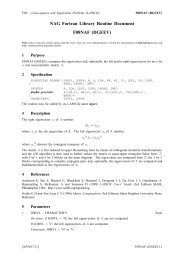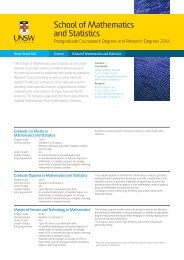2011 Postgraduate Research Competition - UNSW Science - The ...
2011 Postgraduate Research Competition - UNSW Science - The ...
2011 Postgraduate Research Competition - UNSW Science - The ...
Create successful ePaper yourself
Turn your PDF publications into a flip-book with our unique Google optimized e-Paper software.
Page |44<br />
Assessment of vision- related quality of life<br />
in school age amblyopic children<br />
in Saudi Arabia using the <strong>UNSW</strong>-KSU Children’s<br />
Vision for Living Scale<br />
Kholoud Bokhary, Mei Boon and Catherine Suttle<br />
School of Optometry & Vision <strong>Science</strong><br />
Abstract<br />
<strong>The</strong>re is a need to develop and validate a tool for children with amblyopia (lazy eye) in Saudi<br />
Arabia as there is presently no validated instrument have been developed to assess the<br />
effect of amblyopia and its treatment on quality of life in children that are part of the Saudi<br />
Arabian culture and society. Most of the currently available tools are develop and valid for<br />
children with amblyopia in Western countries.<br />
We addressed this need by developing and validating a new tool called the <strong>UNSW</strong>-KSU<br />
Children’s Vision for Living Scale based on a review of the literature and interviews of children<br />
with amblyopia and their families in Australia and Saudi Arabia (n=15). A culture-specific<br />
questionnaire was developed and tested in Saudi Arabia (n=179), analysed using Rasch<br />
methods and revised to include items relating to overall self worth, self esteem, social life,<br />
visual function, physical activity, behaviour and school performance. <strong>The</strong> final version of the<br />
questionnaire was tested in Saudi Arabia (n=101) and found to be valid and reliable (person<br />
reliability 0.86; item reliability 0.92) for that population. Using this scale, we found quality of life<br />
to be lower in children with amblyopia than in age-matched children with normal vision.<br />
An Analysis of OHS Court Prosecution Decisions in<br />
Australia; Predominately NSW, in Identifying<br />
Whether Past OHS Legislative Practice in<br />
Implementation, Compliance and/or Enforcement<br />
[ICE] Influenced Contemporary OHS [MS] Practices<br />
Hung Hua JP and Paul Adam<br />
School of Biological, Earth & Environmental <strong>Science</strong>s<br />
Abstract<br />
<strong>The</strong> endeavor to better understand the elusive dynamics of key decision-makers [i.e.<br />
employers and controllers] in OHS [MS] practices which have continued to disrupt the drive<br />
of Implementation, Compliance and/or Enforcement [ICE] of Occupational Health and<br />
Safety Management Systems [OHS [MS]] practices. <strong>The</strong> analysis took into consideration the<br />
trend between OHS failures [i.e. National v NSW [subset]] and the fatality/non-fatality [i.e.<br />
NOSI v Subset] and with the outcome, to introduce a new OHS [MS] ICE model<br />
[Management of Safe Systems of Work [MoSSoW]] that will assist employers to manage their<br />
ICE obligations. <strong>The</strong>refore, with better understanding of OHS legislation and OHS [MS]<br />
practice requirements and clearer definitions could provide employers with better ways to<br />
deal with an array of misconceived workplaces practices.<br />
science + society |



